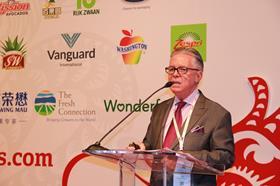
Suppliers looking to export to Asia should avoid being Euro-centric at all costs and avoid “slavishly repeating” marketing strategies that have worked in Europe.
That was the view of managing director of Food Asia Marketing, John Piper, who was speaking today (5 September) at Asiafruit Congress in a session on EU exporters and strategies for success in Asia.
Piper, who helped French kiwifruit brand Oscar break into Asia in the 90s, said the keys to success lie in having a “thorough understanding” and firm grasp of the subtle differences in Asian markets.
“Analyse competitors. Copy them unashamedly within legal limits, and do better where it is possible to do so,” he said. “Do not slavishly repeat what works in Europe. You are in Asia. Avoid at all costs being Euro-centric.”
Suppliers should also work to develop networks and relationships, and invest in marketing a brand to consumers, he added.
Despite the challenges, Piper said opportunities in Asia remain huge, especially in China, which is still seeing year-on-year growth of seven per cent per annum.
“All this is happening while the middle class in Europe and America is shrinking,” he said. “We are witnessing the end of the European global dominance, and we are witnessing the beginning of the era of Asian global dominance. So the question is really, how can you afford not to have a presence in Asia?”
Presenting a case study of EU export success in Asia, Marc Evrard, managing director of Belgian cooperative BFV said the unusual appearance of the Conference pear, with its distinctive russeting, meant the company had to invest a huge amount in consumer education.
“China was interesting to us already around 15 years ago, because as a target market it has a huge population, an interesting retail supply structure, and affordable transport costs,” he said. “Transporting 1kg of fruit from Antwerp to eastern China by truck costs the same amount as transporting to any city in Spain.”
Dole China’s Andy Zhang, who worked with Evrard to introduce Belgian Conference pears to China, explained how in-store displays, innovative packaging and tasting were part of a comprehensive marketing strategy.
“We had to compare Conference pears with our common pear, on colour, shape and taste. This was hard at the beginning. We started in the east with Beijing, Shanghai and Guangzhou. We needed to find a targeted customer for Conference pears in China.
“The shape is completely different – the consumers didn’t recognise this – so we created different packaging to create value add, and become self-selling.”
“Young people want something different, they want something exclusive, so we looked at different formats such as gift packs,” he added.
Exporting a brand into Asia also requires 12-month consistency of supply, according to Alberto Garbuglia, of branded kiwifruit Sweeki marketer Origine Group. Without this, consumers are unable to find their favourite brand in store at any time, which devalues marketing campaigns and enagement, he said.
Garbuglia revealed thatOrigine has recently welcomed a new shareholder, Chilean company David del Curto, to secure the year-round supply of Sweeki and continue expansion across Asia.



